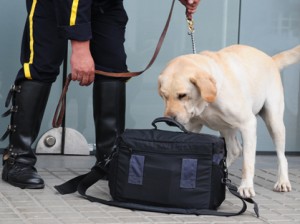TSA Provides Guidance on Explosive Detection Canines
 Late last week, the United States’ Transportation Security Administration (TSA) published new technical, medical, and behavioral standards recommendations for explosive detection canines.
Late last week, the United States’ Transportation Security Administration (TSA) published new technical, medical, and behavioral standards recommendations for explosive detection canines.
These standards are a response to legislation (HR 4577 – the Domestic Explosives Canine Capacity Building Act) that the American Kennel Club (AKC) worked to advance in 2017 and 2018. That legislation directed the TSA to establish a public-private working group to create clear, consistent standards that would be published and adopted by TSA to help remedy the grave shortage of U.S.-sourced explosives detection dogs. The working group consisted of representatives from TSA, the Department of Homeland Security (DHS), a national canine association with expertise in breeding and pedigrees, universities with experience related to explosives detection canines and canine breeding, and domestic canine breeders and vendors. The text of HR 4577 was passed in October 2018 as part of the Federal Aviation Administration Authorization Act. The resulting working group, which included representation by Dr. Carmen Battaglia of AKC, provided guidance to TSA on the development of these recommendations.
The purpose of the recommendations is to provide clear, easily accessible standards for developing and evaluating domestically bred and raised dogs that can be purchased for explosive detection canine (EDC) teams that screen individuals and property at airports. Clearer and more accessible standards are designed to expand opportunities for breeders of high quality domestically bred and raised dogs, and address EDC shortages that have result in the vast majority of U.S. EDCs being imported from overseas.
The new specific standards are consistent with requirements currently used by TSA for dogs purchased under TSA’s explosive detection canine programs.
Summary of recommended standards:
- Technical:
- Identification: Potential candidates should have permanent ID in the form of an implantation of a microchip before being presented for potential purchase.
- Breed: Labrador Retrievers, Flat-Coated Retrievers, Vizslas, German Shorthaired Pointers, and German Wirehaired Pointers.
- Age: between 12-36 months of age at delivery.
- Sex: dogs may be procured reproductively intact.
- Immediate disqualifiers:
- Dogs previously screened or evaluated by the procurer within the previous 30 days.
- Dogs previously determined by procurer to have disqualifying behavioral or medical characteristics in past evaluations.
- Dogs showing signs of fear, shyness, retreating, avoidance behaviors, noise sensitivity, submissive urination, refusal to negotiate objects.
- Dogs with a clear history of aggression or showing aggressive behavior toward human beings or other animals (SWGCANINE guidelines – https://swgcanine.fiu.edu) or toward items and equipment.
- Forced training
- Disease or injury – including displaying potentially infectious disease, or are considered overweight or underweight.
- Medical disqualifications
- Falsification identified in any deliverable records.
- Cumulative disqualifiers:
- Loss of interest in reward object.
- Failure to pursue thrown reward object.
- Visual rather than olfactory search behavior.
- Weak or interrupted search behavior.
- Displays lack of physical stamina.
- Failure to accept being placed in sit position.
- Failure to return to search behavior after being placed in sit position.
- Strong tendency to snatch, claw, or bite.
- Excessive interest in distracting odors or stimuli or preoccupation with scent-marking.
- Failure to follow presentations.
- Overreliance on presentations or encouragement from evaluator/handler.
- Repeated disruption of search behavior due to inability to ignore distractions.
- Frustration demonstrated by barking, other vocalizations.
- Repetitive open mouth searching.
- Dogs requiring excessive amounts of praise to perform tasks.
- Repetitive immature behaviors.
- Medical:
- All dogs should be in excellent health, no acute/chronic disease or condition.
- Medical screening of radiographs of dogs.
- Comprehensive veterinary examination of all dogs that have passed initial behavioral selection process. (Extensive list of requirements.)
- Common medically-disqualifying conditions.
- Behavioral:
- Procurer should offer a demonstration to vendors before placement of an order for canines, to observe a canine being taken through the assessment areas with the procurer’s evaluator, demonstrating how each assessment will be performed. Vendors should be allowed to be present during testing events providing they receive prior approval from the procurer and remain in an observation capacity throughout the assessment.
- Vendor should have prepared the canine sufficiently to be resilient to the stress associated with the procurement process.
- Assessment should begin as soon as the canines are provided to the procurer’s evaluators and continue until canines are accepted or disqualified.
- Dogs for purchase should have a high level of environmental confidence and sociability to be deployed in active, high paced and dynamic environments.
- Vendors should be expected to prepare the canine to meet any required certification standards.
Short URL: https://caninechronicle.com/?p=181791
Comments are closed












